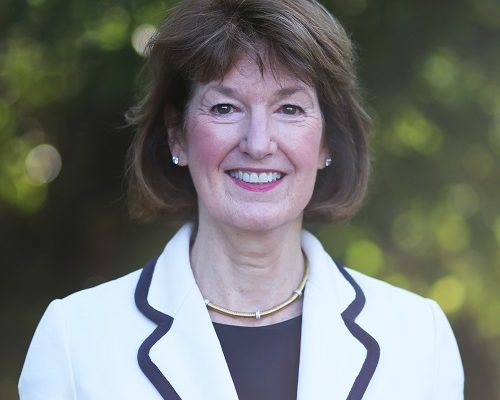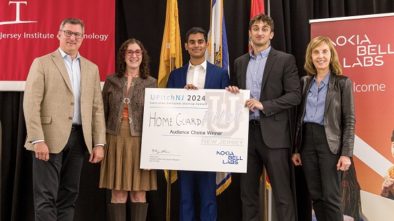Conversation with Janice Mahon: Celebrating Universal Display’s 30th Anniversary
Universal Display Corporation (Ewing), which has been a publicly traded company since 1996, celebrated its 30th anniversary this year. To mark the occasion, NJTechWeekly.com spoke with Janice Mahon, senior VP of technology commercialization and general manager of commercial sales business, who has been a part of the company for most of its history.
Universal Display pioneered the development of energy-efficient, phosphorescent, organic light-emitting diode (OLED) technology, and furthered its incorporation into the TVs, displays and lighting we use today. According to the federal Department of Energy, OLEDs are solid-state devices consisting of thin, carbon-based semiconductor layers that emit light when electricity is applied by adjacent electrodes. For light to escape from the device, at least one of the electrodes must be transparent.
Mahon joined the company in January 1997, after consulting for a couple of months in 1996. There were only three other employees at the time: Sherwin Seligsohn, who founded the company in 1994 after he visited the electrical engineering school at Princeton University and observed research by Stephen Forrest and Mark Thompson in organic light-emitting materials; Sidney Rosenblatt, the company’s longtime CFO and executive vice president, and current board chair; and Steven Abramson, who continues to be the company’s president and CEO.
Mahon’s background includes a chemical engineering degree from Rensselaer Polytechnic Institute and a business degree from Harvard. “When I got out of business school, I really wanted to move into renewable energy,” she said. “Happily, I had a chance to work for a company in Princeton that was developing photovoltaics; and then, a decade or so later, I went on to join a company that was incubating at Rutgers, developing electrochromic technology.” That company was moving to Minnesota, and Mahon wanted to stay in New Jersey. She met Abramson at an intellectual property seminar at Princeton, where they discussed the possibility of her joining Universal Display.
The Company’s Early Days
Mahon has fond memories of the early days at Universal Display. “We were funding research at Princeton University and the University of Southern California (USC). Universal Display gave me an office on the Princeton University campus where I had the opportunity to work with some of the leading scientists and engineers in this field,” she said.
“We really were starting from scratch. We were trying to figure out how to take this little green dot that Sherwin Seligsohn had seen light up for a few seconds at Princeton and monetize it. How do we turn that into a business? And, so, we started to build prototypes in the university labs. We built this little, teeny display that was an OLED; we bought a phone. We took everything out of it, put a couple of batteries inside, and actually made a fake phone that we took around to companies like Lucent at the time, to say, look at this phenomenal display technology!”
Competing technologies at the time included cathode-ray tubes (CRTs) and liquid-crystal displays (LCDs). OLEDs were a more elegant solution, Mahon said. “With a new technology, typically it has X, Y and Z, but it’s missing A or B. When you looked at this new OLED technology, it had the potential to do it all. LCDs were just beginning to replace incumbent CRTs, but when you looked at an LCD, you saw that it took all these layers to make a flat display. It was a Band-Aid. You know, they improved the liquid crystals, they’ve improved the color filter. But it was a kludge of a display, in my mind. And when you look at an OLED, you start with a piece of glass or a piece of plastic, apply thin films, including top and bottom thin-film electrodes and, voila, you have this beautiful light that will emit. We saw the potential that, in the future, it could be very cost-effective with high performance because it was only a series of thin films,” she added.
“And this is why the company has been successful, in my opinion. Those promises still are there. The technology continues to offer better performance. And costs are coming down; and, as they do, OLED displays are entering more and more application spaces.”
Universal Display hasn’t done it alone, she pointed out. “We’ve had wonderful partnerships with Princeton University and the University of Southern California; and then, early on, some of our core customers saw the potential, too. And so we formed marvelous partnerships with the likes of Samsung and LG, who then worked alongside us to take this new technology from development to large-scale commercial manufacturing. Today, our customers are producing millions of millions and millions of OLED displays a day that go into smart phones, TV’s and a variety of other consumer products.”
Today’s Business
Mahon filled us in on Universal Display’s business today. “We manufacture the molecules that are responsible for the red and green light emission, and we are developing molecules that will emit blue light, too. We produce the emitters at several different manufacturing sites here in the United States, as well as in our facility in Shannon, Ireland. And then we sell these products along with our technology. We have a huge patent portfolio that our customers also leverage to produce their display products that go into smartphones and so forth.”
NJTechWeekly.com asked Mahon how the company wound up in New Jersey, given that neither founder Seligsohn, nor CEO Abramson, nor CFO Rosenblatt lived in New Jersey, but rather in the Philadelphia area. She recalled that everyone was spending a lot of time at Princeton University, so they tried to find a location that wasn’t too far away from Princeton or Philadelphia.
Mahon recalled fondly that Julia Brown, the company’s CTO, came on board early on and shared her office at Princeton. While the company’s university partnership has grown in the past 30 years, Universal Display moved off campus after a short time, when it began working on prototypes and “was doing things that looked very commercial.” The company first moved to a little office on top of a liquor store on Nassau Street. They were there for a year, and then moved to Ewing. At first leasing a small part of a building, Universal Display then bought the building as the company grew. As it continued to grow, they expanded further, and the company now has three buildings on the Phillips Boulevard campus in Ewing. Mahon said that about 460 people now work for the company, more than 200 of them in New Jersey.
Today Mahon manages the company’s manufacturing relationship with PPG (Pittsburgh), which produces the Universal Display’s emitters in Pittsburgh and in Ohio, and at the site Universal Display bought in Shannon, Ireland. She also manages the corporate quality program and the customer-facing aspects of selling and distributing products to customers, principally in South Korea and China.
As most companies are doing, Universal Display has been incorporating AI into its strategy. “In our innovation program, we’ve had an AI machine learning team in place for approximately a decade. They had a very specific focus in molecule development: for example, understanding how different functional groups on the molecule could improve the performance of the molecules. We’ve only begun to scratch the surface where AI can help us in other areas, such as our business systems. So, there are lots of opportunities for AI that we want to evaluate as a corporate player.”
Manufacturing prices are coming down for OLEDs, and performance is going up. Smartphone usage is expanding. Mahon explained, “The reason we’ve been so successful is that our technology provides a real energy-saving benefit to that display; and so, as companies like Samsung and Apple add more capability to the phone, there is more demand on power consumption. Making our display materials even more efficient is going to enable them to pour more capability into the smartphone or the device.” According to Mahon, additional growth for the company in the future will be coming in the area of medium-sized displays, which will bring OLEDs into desktop monitors, iPads and laptops, and also onto navigation screens and even auto taillights.
She said, “Performance in the car is a demanding application from the thermal perspective, especially operating in hot and cold temperature extremes. To me, seeing OLEDs penetrating the automotive field is a real validation of the performance of the technology.” Mahon also envisions a time when OLEDs will be used more often in avionics.
As Universal Display evolved, so did its hiring practices. At first, the company hired mostly Ph.D. researchers from Princeton and USC, but as the company grew it added layers of experienced systems managers. Now they hire a balance between the two. “We absolutely want to continue to attract and retain students coming right out of out of graduate programs who bring new ideas, fresh thinking energy,” said Mahon. “But, as we’re growing, we are focusing on the next wave of systematizing or putting in place processes that are going to help us grow into the next decade.”




